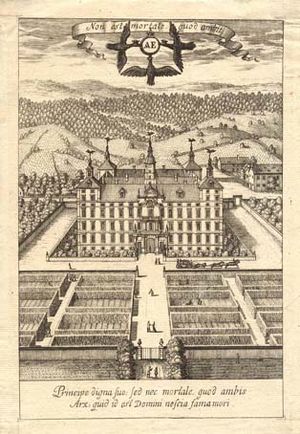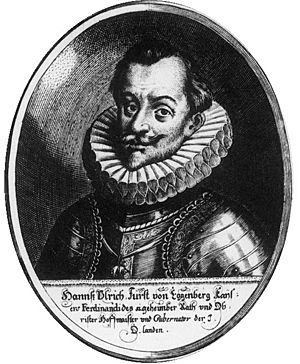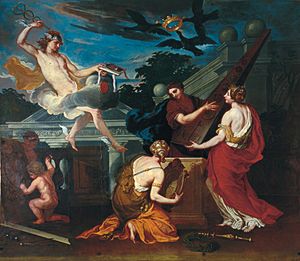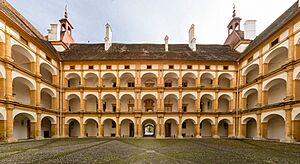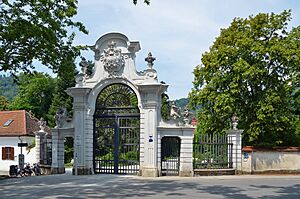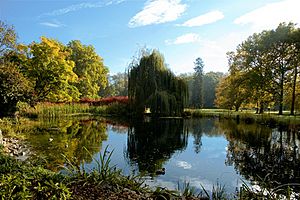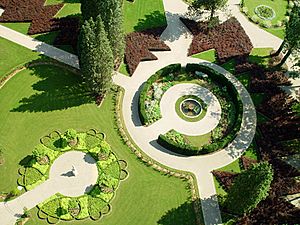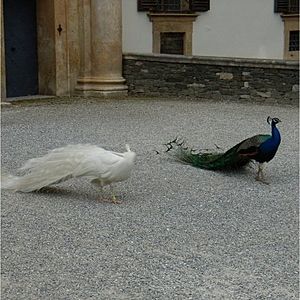Eggenberg Palace, Graz facts for kids
Quick facts for kids Eggenberg Palace |
|
|---|---|
|
Schloss Eggenberg
|
|
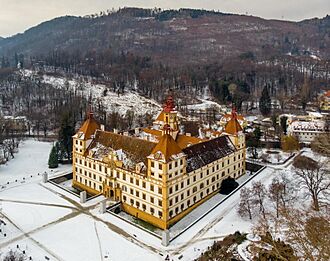
Aerial view in January 2019
|
|
| General information | |
| Type | Palace |
| Architectural style | Gothic and Baroque |
| Location | Graz, Styria, Austria |
| Coordinates | 47°04′26″N 15°23′29″E / 47.07389°N 15.39129°E |
| Elevation | 365 m (1,198 ft) |
| Current tenants | Palace State Rooms, Alte Galerie, Coin Collection, Roman Stonework Collection, Archaeology Collection |
| Construction started | after 1460 (medieval section), 1625 (Baroque expansion) |
| Completed | c. 1635 (structure), 1685 (accouterments), 1762 (piano nobile) |
| Cost | over 105,000 guilder |
| Client | Universalmuseum Joanneum |
| Owner | The State of Styria |
| Height | 50 m (164 ft) (central tower) |
| Dimensions | |
| Diameter | 65 m x 80 m (palace footprint) |
| Other dimensions | 90,000 m² (palace grounds) |
| Technical details | |
| Floor count | 3 |
| Floor area | 8,000 m² |
| Design and construction | |
| Architect | Giovanni Pietro de Pomis |
| Other designers | Hans Adam Weissenkircher (court painter) |
| Official name: City of Graz – Historic Centre and Schloss Eggenberg | |
| Type: | Cultural |
| Criteria: | ii, iv |
| Designated: | 1999 (23rd session) |
| Reference #: | 931bis |
| Region: | Europe and North America |
| Extensions: | 2010 (34th session) included Schloss Eggenberg |
| References | |
|
|
Eggenberg Palace (German: Schloss Eggenberg) is a very important and beautiful palace in Graz, Austria. It is known for its amazing Baroque style. The palace has beautiful gardens and special collections from the Universalmuseum Joanneum. This makes Eggenberg Palace one of Austria's most valuable cultural treasures.
The palace is located on the western edge of Graz. Its design shows the history of the powerful Eggenberg family. In 2010, Eggenberg Palace was added to the UNESCO World Cultural Heritage Sites list. This means it is a very special place that needs to be protected.
The palace is surrounded by walls and has a large entrance facing west. You can reach it by tram. In the northern part of the palace grounds, you'll find the Planetary Garden. There is also a collection of ancient Roman stonework and an Archaeology Museum. This museum holds important items like the Cult Wagon of Strettweg.
Inside the palace, on the ground floor, there is a collection of old coins. This was once the office of Balthasar Eggenberger, who made coins a long time ago. On the upper floor, the Alte Galerie has many paintings, sculptures, and other artworks. These pieces show five centuries of European art history.
Contents
Palace History
Building the Palace
Eggenberg Palace looks like it was all built at once in the 1600s. But parts of it are much older, from the Late Middle Ages. Construction also continued for many years.
Around 1460, Balthasar Eggenberger bought land in Graz. He was a financier for Emperor Frederick III. The Eggenberg family built their home there and made it bigger over time. By 1470, a Gothic chapel was built in a tower. This chapel became the heart of the new palace.
Later, Hans Ulrich von Eggenberg decided to build a grand new palace. He was a very important diplomat and advisor to Emperor Ferdinand II. Hans Ulrich wanted a home that showed his high status. In 1625, he hired Giovanni Pietro de Pomis, a court architect, to design the palace. De Pomis was inspired by El Escorial in Spain. He included the old family home in his new design.
De Pomis oversaw the building until he died in 1631. Other builders finished the work around 1635 or 1636. The decorations were completed between 1641 and 1646.
Palace Changes Over Time
In 1666, Johann Seyfried von Eggenberg, Hans Ulrich's grandson, started making the palace even grander. He wanted it to look like the fancy Baroque style. In 1673, the palace hosted Archduchess Claudia Felicitas for her wedding. Under Johann Seyfried, about 600 paintings were added to the ceilings of the main rooms. These were done in just seven years!
Hans Adam Weissenkircher became the court painter in 1678. He finished the paintings in the main hall, called the Planetary Room, in 1684/85. This completed the first big decorating phase.
After the Eggenberg family line ended, the palace rooms were not used much. The husband of the last Eggenberg princess, Johann Leopold Count Herberstein, ordered a big update. From 1754 to 1762, the palace and gardens were redecorated. This time, it was in the popular Rococo style. The Planetary Room paintings were kept, but other rooms got new wall decorations and furniture. Three special East Asian cabinets were added. The palace theater was also changed into a Baroque church.
The third set of changes happened in the 1800s. These changes were mostly to the living areas on the first floor. The main floor (piano nobile) was left untouched for 100 years. During this time, the formal Baroque garden was changed into a romantic English-style garden.
The Herberstein family owned the palace until 1939. Before World War II, the state of Styria bought the palace and park. The Universalmuseum Joanneum, Austria's oldest museum, took over. After World War II, the museum worked hard to fix damage. In 1953, Eggenberg Palace and its park were opened to the public.
Palace Design and Meaning
The design of Eggenberg Palace is very special. Hans Ulrich von Eggenberg wanted it to represent the cosmos (the universe). He believed in the idea that the world was a well-organized system. Astronomy, astrology, and alchemy were important ideas at the time.
The palace design is based on the Gregorian calendar.
- It has 365 outside windows, one for each day of the year.
- There are 52 windows in the 24 main rooms, representing the weeks.
- The 24 main rooms on the second floor represent the hours in a day.
- Each floor has 31 rooms, like the maximum number of days in a month.
- The 52 windows of the main floor plus the 8 windows of the Planetary Room make 60. This represents the seconds in a minute or minutes in an hour.
The palace is built on a rectangular shape. The middle tower with its Gothic chapel is at the center. Each corner has a tower, representing one of the four seasons. These corner towers point exactly to the main compass directions.
Planetary Room
The Planetary Room is the main hall and the most important of the 24 state rooms. It is filled with oil paintings by Hans Adam Weissenkircher. These paintings show the four elements (earth, air, fire, water), the 12 signs of the Western zodiac, and the seven classical "planets" known in ancient times. The paintings connect the palace's design to the idea of a "Golden Age" ruled by the Eggenberg family.
Piano Nobile
The 24 main rooms on the piano nobile (the main floor) have about 600 ceiling paintings. These paintings tell stories from Greek and Roman mythology, religious scenes from the Old Testament, and historical legends. These ceiling paintings were done in the 1600s.
In the mid-1700s, these rooms were updated in the Rococo style. They got new furniture, chandeliers, and fancy stoves. Most rooms also received new silk wall coverings. Five rooms in the north part of the palace were decorated with large painted canvases by Styrian artist Johann Anton Baptist Raunacher. These paintings show scenes like shepherd's games, theater, gambling, and hunting.
Three special East Asian cabinets were also added. Two of them are decorated with valuable Japanese porcelain and Chinese silk paintings. The third cabinet has eight panels from a rare Japanese folding screen. This screen shows the palace and city of Osaka before 1615. This screen is very important because there are few pictures of Osaka from that time. In 2009, a partnership was made between Eggenberg Palace and Osaka Castle because of this unique screen.
Gardens
The palace and its gardens have always been seen as connected. Each owner made big changes to the gardens.
After the palace was finished, the garden was made much larger. In the late 1600s, it was a formal Italian garden. It had neat flowerbeds, wooded areas, fountains, and places for birds.
Later, Johann Leopold Count Herberstein changed the garden into a French garden. By the 1770s, the Eggenberg Gardens were open for the public to enjoy.
In the early 1800s, people started to dislike the formal Baroque gardens. They wanted gardens that looked more natural. Jérôme Count Herberstein, who loved gardens, changed the Eggenberg Schloss Park into a picturesque English garden. This meant getting rid of mazes, fountains, and straight paths. The goal was to create winding paths and views that made you feel like you were in a beautiful painting. The Rose Mound, which has been restored, was a highlight of this 19th-century garden.
In the early 1900s, interest in the palace gardens decreased. The park became more like a simple city park. In 1993, a project began to restore the gardens. The goal was to bring back the romantic English garden style. Parts of the garden have been rebuilt, like the Breakfast Garden and the Rose Mound.
You can also see peacocks in the Eggenberg Schloss Park. There are white peacocks and the more common Indian blue peacocks. During mating season, the males make loud calls and show off their bright feathers.
Planetary Garden
In the north corner of the grounds, there is a special garden called the Planetary Garden. It has changed many times over the years.
In 2000, a new design for this garden was created. Landscape architect Helga Tornquist used the palace's cosmic theme. The garden now playfully shows the ancient system of planetary "signatures." The Lapidarium, which displays Roman stonework, is also located here.
In 2009, a new underground showroom was opened next to the Lapidarium. This showroom houses the Joanneum's Pre- and Early History archaeological collections. This was ready for the Joanneum's 200th anniversary in 2011.
Commemorative Silver Euro Coin
In 2002, the Austrian Mint created a special silver euro coin to honor Eggenberg Palace. The palace is the main image on the coin. The other side of the coin shows Johannes Kepler. He was a famous scientist who taught in Graz and knew the Eggenberg family. His work on the solar system likely influenced the palace's cosmic design.
See also
 In Spanish: Palacio de Eggenberg para niños
In Spanish: Palacio de Eggenberg para niños
- List of Baroque residences


